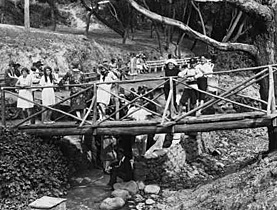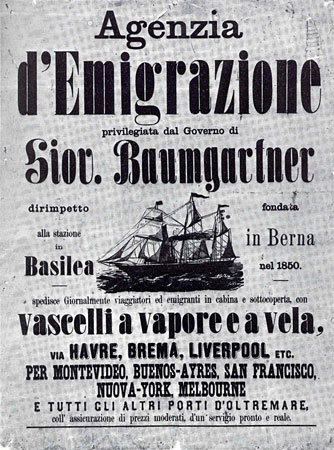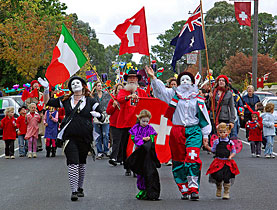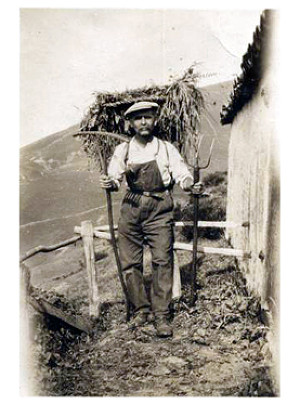A quirk of migration: Swiss-made cricket bats!

What do cricket bats and lavender have to do with Aquilino Tinetti, a native of Biasca in Ticino, who emigrated to Australia in 1860?
Tinetti could not have imagined he would become involved in two activities totally unconnected with Switzerland.
Forget about ice hockey and skiing. In the southern hemisphere, where winter begins on June 1, Swiss sporting tradition is stood on its head.
At Hepburn Springs, in the State of Victoria, when people think of Switzerland, they think of… cricket.
“We were the first to make cricket bats out of willow. Our products have been used by the top Australian players.” Ian Tinetti, a man oozing energy and determination, is proud of his work and his background.
“My great-grandfather Aquilino Tinetti came to Australia in 1860. We have been at Shepherd’s Flat for five generations,”, he says. “We have survived four fires, floods, and two weeks ago the wind tore the roof off our workshop. But we shall never leave this place.”
1,100 bats from one tree
Nestling in the hills near Hepburn Springs, about 50 miles west of Melbourne, the Tinetti family’s Cricket Willow estate is the only place in Australia where you can follow the whole manufacturing process: “from bud to bat”.
“The world record is 1,100 cricket bats from a single willow tree. I once managed 400…,” says Ian, showing us the carpenter’s shop in which the old tools are displayed.
At Shepherd’s Flat, they have been playing cricket since Gold Rush days (1850-1870 in Victoria). Ian’s father, Aquilino “Lino” Tinetti, was a coach of the local team.
“I don’t think the Swiss realise they have a tradition in this sport!”, I comment jokingly.
A unique museum
In recent years, Ian’s passion for sport has been eclipsed by an interest that has been with him since childhood: his family background and ties with distant Ticino. “I decided to scale down my cricket business and devote more time to historical research.”
“I am getting ready to open a sort of museum about the Italian-speaking Swiss. Probably the first of its kind.”
There is certainly no lack of documents. In a room adjacent to the workshop, a dozen giant display panels illustrate the adventures of Swiss – and Italian – pioneers at Hepburn Springs.
“We made them for an exhibition in Melbourne in 2007, when the Museum of Migration staged an event on immigration from Switzerland,” explains Tinetti.
On a table are posters and brochures describing the “tourist attractions” of Ticino. “Today we have welcomed a hundred or so tourists. During their visit, I always show them the “Italian Swiss” room. Many people are amazed: they have never heard of the Swiss presence in this corner of the world.”
A whiff of the past
A few hundred yards from Cricket Willow, I receive a warm welcome from Carol White. Responding to the call of the outback, this enterprising Australian lady left the big city in the late 1980s to purchase and renovate Aquilino Tinetti’s old farmhouse.
“I just loved the architecture. For instance, the stone fireplace, typical of Ticino. I lived here in Aquilino’s old home, but after 17 years I needed somewhere more comfortable and better lit. Can you imagine 15 people living in this place?”
Aware of the entrepreuneurial potential of the immigrants, in 1862 the government of the State of Victoria began encouraging the gold diggers to settle permanently. Some grasped the opportunity to put down roots, buying land and building houses for themselves.
“The migrants from Ticino and Lombardy were skilled stonemasons. Instead of granite, they found sandstone, which is much easier to work,” explains Gael Shannon, Carol White’s partner in the management of Lavandula Farm.
“Many of them failed to make a fortune in the goldmines and, like Aquilino, took up other occupations. They began farming or raising livestock, or opened a grocery store or hotel.
In the cellar of the former Tinetti family home, an old grape press lies discarded in one corner. In the damp atmosphere of this basement room, the old smells still linger. “Here they used to store sausages, cheese, butter and vegetables,” says Shannon.
People deserving respect
Lavandula Farm (covering an area of 40 hectares) is one of the region’s main tourist attractions. The lavender fields, olive trees, vineyards, boules pitch and open-air trattoria give the farm a Mediterranean feel.
In the old stables – where Aquilino kept his cows and horses – there is an exhibition of local produce: cordials, organic foods, lavender oils, creams and soaps, wicker baskets, clothing…
As at Cricket Willow, an area is devoted to memorabilia of the Swiss and Italian settlers. “They were much respected,” insists White. “Their names are still very much with us: in the telephone directory and in the little graveyards hereabouts…”
Luigi Jorio in Hepburn Springs, swissinfo.ch
The first Swiss definitely known to have landed in Australia was the Bernese Johann Wäber. On Captain James Cook’s third voyage of exploration (1776-1779), Wäber was recruited to record the expedition in drawings and paintings.
From the 1840s, Swiss wine-growers, mainly from the Neuchâtel region, began settling in the State of Victoria.
The number of Swiss immigrants increased dramatically between 1850 and 1870, at the time of the Gold Rush.
Some 2,000 migrants arrived from Ticino. They settled mainly around the little towns of Bendigo, Ballarat and Daylesford/Hepburn (Jim Crow), north-west of Melbourne.
Those who did not strike it rich in the goldfields worked for the big mining companies or took up other occupations (agriculture, shop-keeping, running hotels…).
While some settled permanently in Australia, working hard and making a modest living, many returned home empty-handed and in debt, or embarked on new adventures in the goldfields and on the ranches of California.

In compliance with the JTI standards
More: SWI swissinfo.ch certified by the Journalism Trust Initiative





You can find an overview of ongoing debates with our journalists here. Please join us!
If you want to start a conversation about a topic raised in this article or want to report factual errors, email us at english@swissinfo.ch.